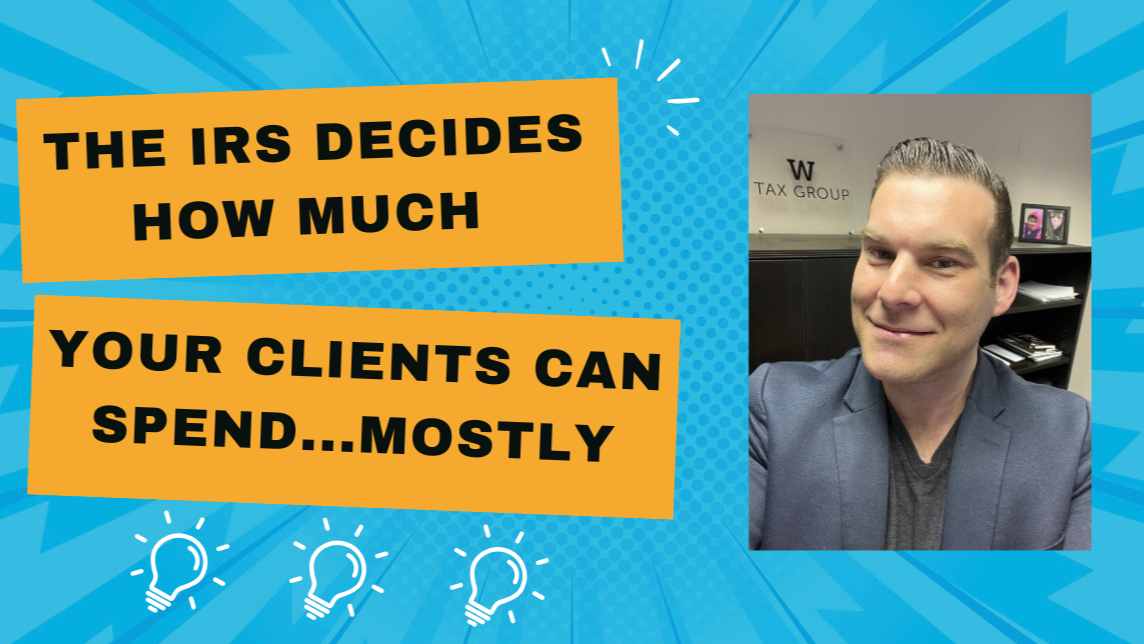The IRS Decides How Much Your Clients Can Spend...Mostly
Imagine telling one of your clients, “Sorry, the IRS has decided you don’t need that second car… or the ‘extra’ money you spend on groceries… or the medical bills you’re barely keeping up with.”
That’s not a hypothetical. That’s how IRS Collection Financial Standards work.
The IRS cares about whether taxpayers have filed their returns and how much they owe but when it comes to tax relief programs, the IRS cares about how they live.
What do they eat? Where do they live? How much gas do they put in their car? The IRS has an opinion on all of it—and they’ve put those opinions into hard numbers.
For professionals like you—CPAs, bankruptcy attorneys, mortgage lenders, financial advisors—this matters. Because when your client is under IRS scrutiny, their lifestyle suddenly becomes a negotiation point.
Why This Matters
When clients are trying to resolve tax debt, the IRS doesn’t simply take their word on “what they can afford.” They measure expenses against Collection Financial Standards—a national and local set of allowances for food, clothing, housing, transportation, and medical care.
If your client spends more than those limits, the IRS may say, “Too bad—use that excess to pay us.”
Here’s the catch: those standards often don’t reflect reality. And if clients don’t know how to navigate them? Their request for relief may be dunzo.
The 5 Key Things You Need to Know
1. National vs. Local Standards
National Standards: Cover food, clothing, personal care, housekeeping supplies, and out-of-pocket medical expenses.
Local Standards: Apply to housing, utilities, and transportation, pegged to county-level costs.
A client in San Francisco gets nearly $6,000/month in housing allowances for a family of five. That same family in rural West Virginia? Just $1,500.
2. How the IRS Uses Them
The IRS applies these standards when:
Reviewing an Offer in Compromise.
Approving a Partial Payment Installment Agreement.
Determining Currently Not Collectible status.
Setting up payment plans over $250,000.
If your client wants real relief, the standards are the gatekeeper.
3. When Standards Don’t Apply
If a client owes less than $250k and can pay within how ever many months remain on the statute of limitations, they may qualify for a nondisclosure installment agreement—no financial standards required.
But that only makes sense under certain circumstances.
If you're trying to negotiate a partial pay installment agreement or are currently not collectible, a nondisclosure IA does not apply.
4. Exceptions Are Possible
Here’s the part most clients miss: the IRS can allow necessary expenses outside the standards—but only if you prove the case.
Examples include:
Expenses above the allowable standards.
Childcare needed to keep working.
Union dues or mandatory work deductions.
Tools or equipment required for income.
Certain insurance or state tax payments.
Without documentation? Denied. With a strong case? Approved.
5. The Standards Are Tight
Make no mistake: these aren’t generous allowances. As of 2025, a single adult gets $839/month for food, clothing, and household items. That’s less than many Americans spend at Costco.
Transportation? $662 for one car. Medical expenses? $84/month if under 65. For many clients, those numbers are laughably low. But for the IRS, that's what's allowed—unless you challenge them.
TL;DR
⏩ The IRS uses Collection Financial Standards to decide how much a client can spend while paying tax debt.
⏩ National standards cover food, clothing, and medical care.
⏩ Local standards cover housing and transportation.
⏩ Clients over the limits may see their relief requests denied.
⏩ Exceptions exist—but only if carefully documented.
➥ Contact Attorney Stephen A. Weisberg for a free Tax Debt Analysis.
Contact Me Here: https://www.weisberg.tax/contact-1
Email: sweisberg@wtaxattorney.com
Phone/Text: (248) 971-0885
Address: 300 Galleria Officentre, Suite 402, Southfield, MI 48034
